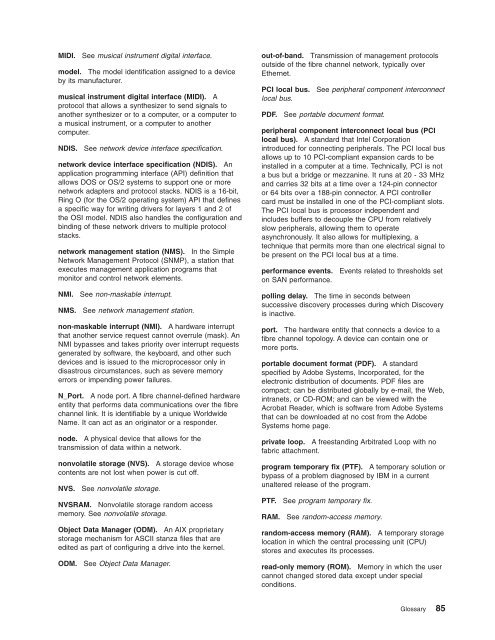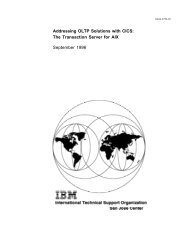install–38 - Ibm
install–38 - Ibm
install–38 - Ibm
Create successful ePaper yourself
Turn your PDF publications into a flip-book with our unique Google optimized e-Paper software.
MIDI. See musical instrument digital interface.<br />
model. The model identification assigned to a device<br />
by its manufacturer.<br />
musical instrument digital interface (MIDI). A<br />
protocol that allows a synthesizer to send signals to<br />
another synthesizer or to a computer, or a computer to<br />
a musical instrument, or a computer to another<br />
computer.<br />
NDIS. See network device interface specification.<br />
network device interface specification (NDIS). An<br />
application programming interface (API) definition that<br />
allows DOS or OS/2 systems to support one or more<br />
network adapters and protocol stacks. NDIS is a 16-bit,<br />
Ring O (for the OS/2 operating system) API that defines<br />
a specific way for writing drivers for layers 1 and 2 of<br />
the OSI model. NDIS also handles the configuration and<br />
binding of these network drivers to multiple protocol<br />
stacks.<br />
network management station (NMS). In the Simple<br />
Network Management Protocol (SNMP), a station that<br />
executes management application programs that<br />
monitor and control network elements.<br />
NMI. See non-maskable interrupt.<br />
NMS. See network management station.<br />
non-maskable interrupt (NMI). A hardware interrupt<br />
that another service request cannot overrule (mask). An<br />
NMI bypasses and takes priority over interrupt requests<br />
generated by software, the keyboard, and other such<br />
devices and is issued to the microprocessor only in<br />
disastrous circumstances, such as severe memory<br />
errors or impending power failures.<br />
N_Port. A node port. A fibre channel-defined hardware<br />
entity that performs data communications over the fibre<br />
channel link. It is identifiable by a unique Worldwide<br />
Name. It can act as an originator or a responder.<br />
node. A physical device that allows for the<br />
transmission of data within a network.<br />
nonvolatile storage (NVS). A storage device whose<br />
contents are not lost when power is cut off.<br />
NVS. See nonvolatile storage.<br />
NVSRAM. Nonvolatile storage random access<br />
memory. See nonvolatile storage.<br />
Object Data Manager (ODM). An AIX proprietary<br />
storage mechanism for ASCII stanza files that are<br />
edited as part of configuring a drive into the kernel.<br />
ODM. See Object Data Manager.<br />
out-of-band. Transmission of management protocols<br />
outside of the fibre channel network, typically over<br />
Ethernet.<br />
PCI local bus. See peripheral component interconnect<br />
local bus.<br />
PDF. See portable document format.<br />
peripheral component interconnect local bus (PCI<br />
local bus). A standard that Intel Corporation<br />
introduced for connecting peripherals. The PCI local bus<br />
allows up to 10 PCI-compliant expansion cards to be<br />
installed in a computer at a time. Technically, PCI is not<br />
a bus but a bridge or mezzanine. It runs at 20 - 33 MHz<br />
and carries 32 bits at a time over a 124-pin connector<br />
or 64 bits over a 188-pin connector. A PCI controller<br />
card must be installed in one of the PCI-compliant slots.<br />
The PCI local bus is processor independent and<br />
includes buffers to decouple the CPU from relatively<br />
slow peripherals, allowing them to operate<br />
asynchronously. It also allows for multiplexing, a<br />
technique that permits more than one electrical signal to<br />
be present on the PCI local bus at a time.<br />
performance events. Events related to thresholds set<br />
on SAN performance.<br />
polling delay. The time in seconds between<br />
successive discovery processes during which Discovery<br />
is inactive.<br />
port. The hardware entity that connects a device to a<br />
fibre channel topology. A device can contain one or<br />
more ports.<br />
portable document format (PDF). A standard<br />
specified by Adobe Systems, Incorporated, for the<br />
electronic distribution of documents. PDF files are<br />
compact; can be distributed globally by e-mail, the Web,<br />
intranets, or CD-ROM; and can be viewed with the<br />
Acrobat Reader, which is software from Adobe Systems<br />
that can be downloaded at no cost from the Adobe<br />
Systems home page.<br />
private loop. A freestanding Arbitrated Loop with no<br />
fabric attachment.<br />
program temporary fix (PTF). A temporary solution or<br />
bypass of a problem diagnosed by IBM in a current<br />
unaltered release of the program.<br />
PTF. See program temporary fix.<br />
RAM. See random-access memory.<br />
random-access memory (RAM). A temporary storage<br />
location in which the central processing unit (CPU)<br />
stores and executes its processes.<br />
read-only memory (ROM). Memory in which the user<br />
cannot changed stored data except under special<br />
conditions.<br />
Glossary 85
















